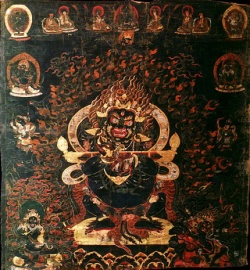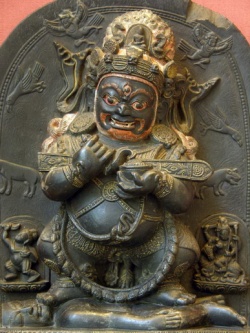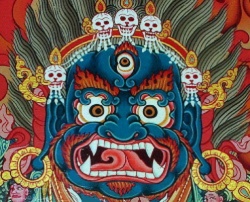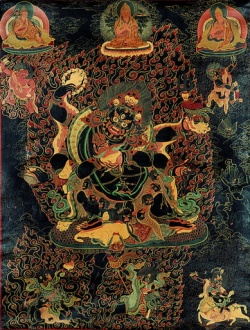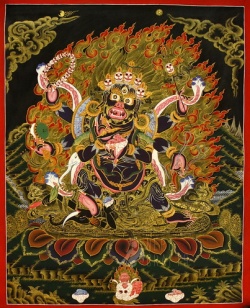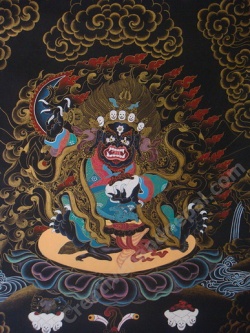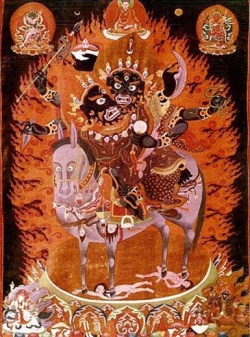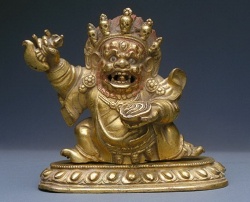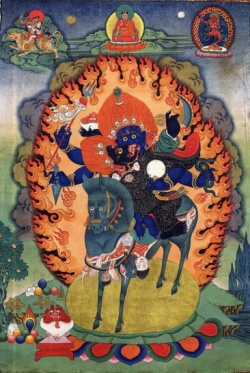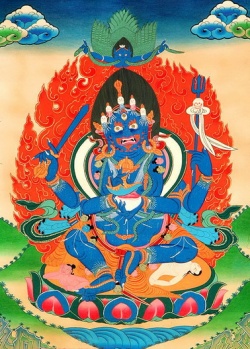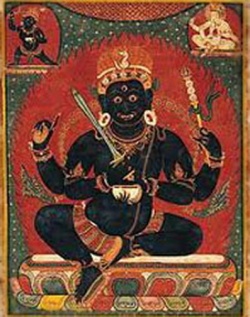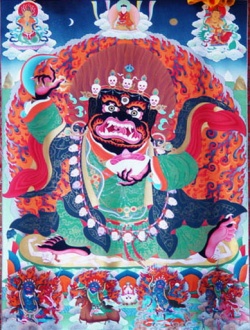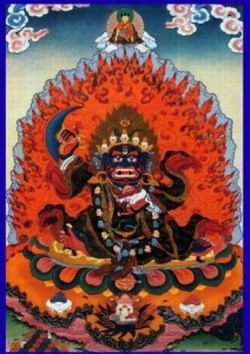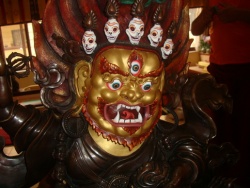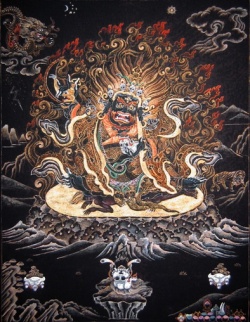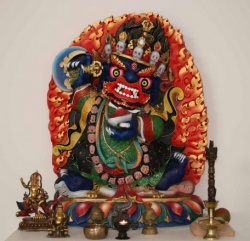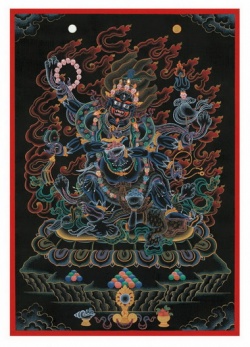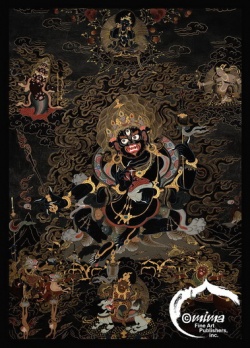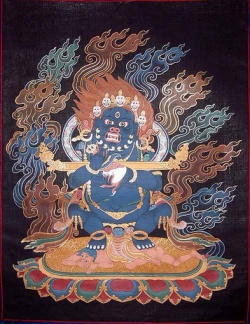Mahakala
Mahākāla (Sanskrit) is a Dharmapala ("protector of dharma") in Vajrayana Buddhism, and a deity in Chinese and Japanese Buddhism, particularly in the Vajrayana school.
He is known as Daheitian (大黑天) in Chinese and Daikokuten (大黒天) in Japanese.
Mahākāla belongs to the fourth hierarchy of deities.
In Hinduism, Mahakala is a name of Shiva, Lord Shiva himself is Time or he is God of Time, kala/kaal means Time, atit/bhoot kaal (past),vartman kaal (present) and bhavishya kaal (future) - these all formats of time are merged in lord Shiva .
Kala means also death and Shiva is also god of destroy, destroy means end or death, so Shiva is Mahakala. (as, for example, at the Shiva temple in Ujjain that is more than once mentioned by Kālidāsa), but it is also a name of one of his principal attendants (Sanskrit: gaṇa):
along with Nandi, which is Shiva's mount(vahana), and so is often represented outside the main doorway of early North Indian temples. In Sikhism, Mahakaal is main term used for "Hukam"(The Supreme Command) in Dasam Granth, written by Guru Gobind Singh.
Name
Mahākāla is a Sanskrit bahuvrihi of mahā (महत्; "great") and kāla (काल; "time/death"), which means "beyond the time" or death.
The literal Tibetan translation is "Nagpo Chenpo" (Tibetan: ནག་པོ་ཆེན་པོ།) though, when referring to this deity,
Tibetans usually use the word Gönpo (Tibetan: མགོན་པོ།, Wylie: mgon po), the translation of the Sanskrit word Nātha meaning "lord" or "protector",
Description
Mahākāla is relied upon in all schools of Tibetan Buddhism.
However, he is depicted in a number of variations, each with distinctly different qualities and aspects.
He is also regarded as the emanation of different beings in different cases, namely Avalokiteśvara (Wylie: spyan ras gzigs) or Cakrasaṃvara (Wylie: ’khor lo bde mchog).
Mahākāla is typically black in color.
Just as all colors are absorbed and dissolved into black, all names and forms are said to melt into those of Mahakala, symbolizing his all-embracing, comprehensive nature.
Black can also represent the total absence of color, and again in this case it signifies the nature of Mahakala as ultimate or absolute reality.
This principle is known in Sanskrit as "nirguna", beyond all quality and form, and it is typified by both interpretations.
Mahākāla is almost always depicted with a crown of five skulls, which represent the transmutation of the five kleśās (negative afflictions) into the five wisdoms.
The most notable variation in Mahākāla's manifestations and depictions is in the number of arms, but other details can vary as well.
For instance, in some cases there are Mahakalas in white, with multiple heads, without genitals, standing on varying numbers of various things, holding various implements, with alternative adornments, and so on.
Manifestations
Six-Armed Mahākāla
Nyingshuk came from Khyungpo Naljor, the founder of the Shangpa Kagyu, and spread to all the lineages—Sakya, Nyingma, and Geluk, as well as various Kagyu lineages.
There are also Terma lineages of various forms of Six Armed Mahākāla.
Nyinghsuk, though derived from the Shangpa, is not the major Shangpa one—it's in a dancing posture, rather than standing straight up, and is a very advanced Mahakala practice.
There is also a White Six-Armed Mahakala (Skt: Shad-bhuja Sita Mahakala; Tib. Wylie: mGon po yid bzhin nor bu) popular among Mongolian Gelugpas.
Four-Armed Mahākāla
Various Four-armed Mahākālas (Skt. Chatur-bhuja Mahākāla, Tib. Wylie: mGon po phyag bzhi pa) are the primary protectors of the Karma Kagyu, Drikung Kagyu and the Drukpa Lineage of Tibetan Buddhism.
A four-armed Mahākāla is also found in the Nyingma school, although the primary protector of the Great Perfection (Skt: Mahasandhi, Tib. Dzogchen) teachings is Ekajati.
Two-Armed Mahākālas
The two-armed Mahākāla called Bernakchen (Black Coat) is a protector of the Karma Kagyu school, although he derives from Nyingma terma and was adopted by the Karma Kagyu during the time of 2nd Karmapa, Karma Pakshi.
He is often depicted with his consort Rangjung Gyalmo.
(He is often thought to be the primary protector, but he is actually the main protector of the Karmapas specifically.
Mahākāla Chakshipa, a four-armed mahakala, is technically the primary protector.
Chakdrupa, a six-armed mahakala, is also common in the Kagyu.)
Panjaranatha Mahākāla, "Lord of Charms" or "Lord of the Pavilion", an emanation of Manjushri is a protector of the Sakya order.
Mahākāla in Japan
- See also: Daikoku-ten
Mahākāla (known as Daikokuten 大黑天) enjoys an exalted position as a household deity in Japan, as he is one of the Seven Lucky Gods in Japanese folklore.
Mahākāla's association with wealth and prosperity gave rise to a strange custom known as Fuku-nusubi.
This custom started with the belief that one who stole divine figures (gods and goddesses) was assured of good fortune, if not caught in the act of stealing.
In the course of time, stealing of divine images became so common a practice in Japan that the Toshi-no-ichi or the ‘year-end-market’ held in the Asakusa Kannon temple became the main venue of the sale and disposal of such images by the fortune-seekers.
Many small stalls were opened where articles including images of Mahakala were sold on the eve of New Year celebrations.
The Japanese also use the symbol of Mahākāla as a monogram.
The traditional pilgrims climbing the holy Mount Ontake wear tenugui on white Japanese scarves with the Sanskrit seed syllable of Mahākāla.
In Japan, this deity is variously considered to be the god of wealth, or of the household, particularly the kitchen.
He is recognised by his wide face, smile, and a flat black hat, in stark contrast to the fierce imagery portrayed in Tibetan Buddhist art.
He is often portrayed holding a golden mallet, otherwise known as a magic money mallet, and is seen seated on bales of rice, with mice nearby (mice signify plentiful food).
Mahākāla in Hinduism
In some part of Orisa, Jharkhand and Dooars, that is the northern Bengal localities wild elephants are worshiped as Mahākāla.
Source
Mahakala (Skt. mahākāla; Tib. མགོན་པོ་, ནག་པོ་ཆེན་པོ་, Wyl. nag po chen po, but usually mgon po) - a supermundane dharma protector who appears in a number of forms, such as Four-armed Mahakala, Six-armed Mahakala, Gönpo Maning and Pañjaranatha (Gurgyi Gönpo).
External Links
Source
Mahākāla. (T. Nag po chen po; C. Daheitian; J. Daikokuten; K. Taehŭkch’ŏn 大黑天).
In Sanskrit, the “Great Black One”; one of the most important wrathful deities of tantric Buddhism.
He is a Dharmapāla or “protector of the dharma,” of the Lokottara or “supramundane” variety; that is, one regarded as the manifestation of a buddha or bodhisattva. He is said to be the wrathful manifestation of Avalokiteśvara, the bodhisattva of compassion.
In the form of Avalokiteśvara with a thousand arms and eleven heads (see Sāhasrabhujasāhasranetrāvalokiteśvara), the top head is that of Mahākāla. He has many aspects, including two-, four-, and six-armed forms, and appears in several colors, the most famous being black and white.
He wears a crown of five skulls, symbolizing the transmutation of the five afflictions (Kleśa) into the five wisdoms (Pañcajñāna) of a buddha. One of his most popular forms in Tibet is as Pañjaranātha or “Protector of the Pavilion.”
In this form, which derives from the Vajrapañjaratantra, he is the protector of the Hevajra Tantra cycle.
Here is depicted as a dwarf-like figure, holding a wooden staff across his arms.
In Japan, where he is known as Daikokuten, Mahākāla is a less frightening figure and is one of the “seven gods of good fortune” (Shichifukujin), extolled as a god of wealth and a god of the household.
Source
The Princeton Dictionary of Buddhism by Robert E. Buswell Jr. and Donald S. Lopez Jr.
Interpreting the Symbolism
Khenpo Karthar reminds us ("Relating to the Mahakala Practice," Densal:
- "Mahakala is seen standing on the corpse of two human bodies, thus symbolizing the death of negativities and the complete uprooting of negative patterns to such a point that, like a dead body, they will not come to life.
- It is very important that we know these symbols of Mahakala because many times we have mistaken notions that he may be a clinging spirit or harmful, evil being, perhaps even the Lord of Death ready to devour and attack. One would find great difficulty in relating to the various symbols without understanding that our awakened compassion is the essential quality of the being of Mahakala.
- Mahakala has never been known to harm one being, even in the slightest manner, because he is constantly benefiting beings through the continuous play of the enlightened mind."
Mahakala is a Protector of all Tibetan Buddhism
The form varies according to the different teaching lineages.
For example, there is the two-armed, big-mouthed Mahakala Bernakchen of the Karma Kagyu, the four-armed Mahakala who is protector of the Drikung Kagyu, and six-armed Mahakala of the Gelugpas described below.
They are not all wrathful forms of Chenresi [Skt.: Avalokiteshvara) although
- "There is an emanation of Avalokiteshvara which arose in the form of Mahakala and this is the Shangpa Kagyu Mahakala with one face and six arms, in a standing posture.
form was later adopted by Tsongkhapa and followers as the main protector of the Gelugpa School.
- Mahakalas can arise from various sources namely Vajradhara and the Anuttarayoga Tantras but are not generically Avalokiteshvara."
There is a white one associated with prosperity, and also a eunuch and some feminine forms, but it is incorrectly held that there are 75 variants.
" . . . the different Mahakalas with various number of arms are not all the same.
The Six-Armed version is the emanation of Chenrezig (in association with the head-blowing-up episode) and was originally the specialty of Shangpa Kagyu, but has now been adopted all over;
one of the Four-Armed versions is an emanation of C[h]akrasamvara and the main protector of Karma Kagyu; the two-armed Bernakchen, an emanation of Samantabhadra, is actually not the main protector of Karma Kagyu, but rather that of the Karmapas specifically, although there is nothing that says the rest of us cannot also practice on him; the Sakyapa has the two-armed Panjaranatha Mahakala, who probably is an emanation of Manjushri and holds the rod that emanate[s] many Mahakalas.
Like many of the other protectors, one pair[s] up with any one of these Mahakalas as appropriate to their cycle of practice; in other words, one doesn't just pick up a Mahakala out of the blue."
~ BB to the Kagyu email list, June 2002.
Ritual Practice
Students do not generally do practices associated with dharmapalas such as Mahakala until they have completed the Preliminary or Foundation Practices and of course, after receiving the empowerment to do so.
The Sanskrit descriptive name, Mahakala (Great Time or Great Dark One) is also used to refer to Lord Shiva, the Hindu god whose tandava dance sustains, but can also destroy, the universe of appearances, and who is associated with Time, another meaning of kala.
The teaching known as the Kala-chakra or Wheel of Time, is a Buddhist tantric system thought of as the key to reality that unites the universe, time and the breath of life.]
Lama C. Reed says that in the liturgy known as Kha Yig Ma, which is the KTD daily practice, a short (3-page) Chagdrupa is performed incorporating the visualization, torma offering and mantra recitation.
A mid-length, "Tsendring" Mahakala practice is done on the 29th lunar day in KTD's 3-year retreat, and in the afternoon of the first day of the yearly Mahakala drupchen, KTD uses the same brief Chagdrupa liturgy, and that this is one is also a part of the Gyespa (extensive) Mahakala ritual.
At KTD, each of the 3 days of Mahakala Drupchen begin with the Dorje Phagmo self-visualization liturgy followed by the recitation of the Gyespa text, which broadly speaking, is a collection of short visualization/torma offering liturgies and mantras of the central Kamtsang protectors, Bernagchen and consort.
Mahakala Bernakchen
Kubilai Khan succeeded his Buddhist brother Munga, and fearful of the influence of Karma Pakshi, the second Karmapa, had him confined to the Chinese Imperial Palace where he was tied by his beard (among other terrible ordeals.)
Karmapa prayed to Mahakala Bernagchen, but "Great Black Cloak" took so long putting on his boots, that by the time he got there, the ordeal had ended.
However, as he had been summoned, he was obliged by rules of combat to cleave something with the hook-knife that he held at the ready.
The Karmapa therefore had him strike the palace. As a result, there is still a gash somewhere in the Imperial Palace.
There is a version saying the Karmapa struck Mahakala for his tardiness, giving him his swollen face! Consequently, no subsequent Karmapa has ever worn a beard.
Origin of Mahakala
The compassion of the red Buddha Amitabha manifested as Avalokiteshvara who took a vow to forgo his own enlightenment until all the realms of samsara had been emptied.
This vow required a renewal of determination, and so with Amitabha's blessing, Avalokiteshvara next assumed a form with eleven heads and a thousand arms. Still he had been unable to benefit even a few beings.
Therefore after reflecting for one whole week, he determined that by assuming a wrathful form he would be able "to subdue the degenerate beings of this Age of Darkness."
Also he saw that even beings who practiced Dharma were unable to escape from the Bardo realms (time between rebirths where beings may face great anxiety and terrifying experiences) and he thought that in wrathful form he could also protect them in that way.
And lastly, he thought that the beings in this Dark Age were poor and needy, experiencing only suffering after suffering, and that in wrathful form he could provide them an antidote to that suffering so that by simply making the wish (for protection) their needs could be met.
These three motives made his determination even greater than before and so from the heart of Noble Avalokiteshvara emerged a dark blue HUNG syllable that immediately became the Instantaneous Protector of Wisdom, Mahakala.
The foundations of all the Pure Lands shook with six kinds of earthquakes, and the Conquering and Transcending One of Immeasurable Light (Amitabha) and all the other Tathagatas of the ten directions proclaimed with one voice:
- "Son of the family, it is well that you have made this resolution. You shall have the empowerment of all the wisdom dakinis.
You shall have the strength of the wrathful Yama, Lord of Death. You shall have the mountain spirits, the yakshas, the devils and the demonesses as your messengers.
You shall embody the great wrathful empowerments of the Body, Speech, Mind, Qualities and Activity of all the Buddhas throughout the three times."
Ever since, bodhisattva Mahakala is the Dharma (Buddha's Doctrine) Protector of all Buddha fields.
Symbolism of Mahakala in the 6-armed Manifestation:
The Protector's body is midnight blue, symbolic of the changeless Dharmakaya.
His three eyes symbolize his knowledge of the past, present and future, and also the manifestation of the three bodies of Buddha.
The crown adorned with five skulls symbolizes the transformation of the five poisons of anger, desire, ignorance, jealousy and pride into the five wisdoms.
His six arms symbolize the attainment of the six Perfections:
generosity, patience, morality, diligence, meditation and wisdom.
The kartika or triku [or trigu, pron. tigu) the ritual curved knife, cuts attachment to ego.
The kapila or skull bowl filled with blood symbolizes the subjugation of the maras or evil ones. (An alternate interpretation can be found in other contexts.)
The rosary symbolizes his continuous activity for the benefit of beings.
The damaru or hand-drum symbolizes his power over the dakinis. (Also, different interpretations in other contexts.)
His trident symbolizes his power over the three kayas -- the spheres of desire, form and formlessness. (An alternate interpretation can also be found.)
The lasso binds those who break their vows.
His two feet are the means and the wisdom to accomplish his task. That his left leg is straight and his right leg bent symbolize his accomplishment of the benefit to oneself and to others. He tramples on a vinayaka, to symbolize his destruction and dispersal of great obstacles.
The sun on which he stands symbolizes his illumination of the darkness of ignorance.
His lotus seat symbolizes purity undefiled by samsara.
The surrounding blazing fire symbolizes his activity that consumes neurotic states.
The tiger skin stands for purification of desire; the elephant skin for purification of pride, and the snake, for the purification of anger.
His other ornaments together symbolize that he has all the qualities of a Buddha.
The material about the symbolism of 6-armed Mahakala derives from a Gelugpa sadhana (ritual) of Tara that includes an offering to Mahakala. The whole was produced in Jan. 1994 by Dharma Therapy Trust under Ven.
Geshé Damchö Yönten and is available unedited at Lamrim.org.uk
Source
This is the wrathful form of Avalokiteshvara, the Bodhisattva of Compassion.
He protects from dangers and bad influences that might hinder a monks approach to enlightenment.
Mahakala is seen as the protector of the Dalai Lamas.
A Dharma Protector who appears in many different aspects aE four armed, six armed, four faced, and so forth.
Source
By Tom Suchan and Chaya Chandrasekhar
8 June, 1998
Mahakala is the fierce manifestation of Avalokiteshvara, the Bodhisattva of absolute compassion, and the primary Dharmapala, or "Dharma protector" in Tibetan Buddhism. Mahakala's name translates as the "Great Black," one, or "Great time."
The latter is a reference to the deity's ability to transcend all time. More than seventy-five forms of Mahakala are known in Tibet where he is generally called mGon po, or the "Master," "Lord," or "Protector."
Mahakala is characteristically depicted with an angry face, pot-bellied, and standing on a human corpse or the elephant-headed, Hindu god, Ganesha, who, in this case, signifies hindrances.
He is dark, often black or blue in color, although the color may vary depending on the specific form being represented.
In the SAMA collection, a red Mahakala, associated with the intermediary southwest direction, is depicted in #97.085, a portrait of Bromdon.
Sita, or white Mahakala is seen as a subsidiary figure in #93.014, a large painting of he protector, Gur-gyi Mgon Po.
In each of his two, four, six or sixteen hands, Mahakala holds the kapala and katrika, a trident, mala, or prayer beads, a noose, the heart of a vanquished enemy, a damaru, or kettle drum, sword, khatvanga and so on.
His primary attributes are the kapala, or skull cup, and the katrika, or chopper.
The skull cup and its contents represent the five sense offerings, while the chopper represents detachment from samsaric existence.
Mahakala in his six-armed form, trampling Ganesha, is the central figure in the SAMA painting, #97.082.
In his upper left and right hands he holds the severed skin of an elephant, symbolizing the ability to overcome delusion.
Along with the elephant skin, he holds prayer beads and a trident in his upper right and left hands respectively.
his lower right hand he holds the heart of an enemy who hinders religious attainment.
In his lower left hand he holds a noose. The katrika and kapala are held in each of his primary hands.
He is wears a garland of freshly severed heads around his body while a green snake, tied across his shoulder and body, serves as the sacred thread.
A blue Buddha figure, making bhumisparsha, or earth-touching gesture, is depicted in the center of Mahkala's elaborate hair arrangement.
This figure is probably the Buddha Shakyamuni or, the jina Buddha Akshobhya.
In the top center is a representation of the Adi Buddha, Vajradhara, the progenitor of all the figures in the painting.
Two Mahasiddha-type figures flank Vajradhara. Other figures along the top row include various teachers.
Two Buddha figures are depicted directly below the teachers in the top left and right corners of the painting.
The Buddha on the left is white and makes the Dharmachakra, or teaching, gesture.
The damaged condition of the painting obscures the proper identification of the Buddha on the right.
Manjushri, the Buddha or Bodhisattva of absolute wisdom, is depicted on the left, within the flames that surround Mahakala.
On the right is the Buddha Amitayus, seated in the meditation posture, while holding the vase of life.
Four figures, probably belonging to Mahakala's retinue, are shown on either side of Mahakala.
The two figures on the left stand on human corpses and hold various attributes.
The figures on the right ride on animal mounts. The top right figure may be Mahakala's primary attendant, Dugon Trakshad, who rides on a black horse.
Dugon Trakshad generally carries a flaming sword in his right hand and a skull cup in his left. In the SAMA painting, however, the figure on the black horse holds a kapala in his left hand and a banner trident in his right.
The lower right figure, riding on a mule-like animal is probably Palden Lhamo, the female attendant of Mahakala.
In each of her four hands she holds a sword, a trident and the skull-cup and chopper.
The figure in the bottom center is possibly Kshetrapala, who frequently attends to Mahakala.
He is known to ride on a black bear while holding a vajra chopper and skull cup.
However, the sketchy representation of the animal mount in the SAMA painting does not allow a definite attribution.
Along the bottom of the painting, on either side of the lower central figure, are representations of the guardians of the ten directions, each on his specific animal mount.
Included in this group, and easily identifiable, are Indra on the upper left, Nairiti on a human corpse and Varuna on the crocodile to the lower central figure's immediate right.
A Multi-headed figure of Brahma is depicted on the far right side of the painting.
figure holding a trident and skull cup, wearing a long skirt, is depicted above the image of Indra on the left.
This may be the goddess, Ekajathi, often considered a member of Mahakala's retinue.
In the corresponding position on the right is a bull-headed figure, probably Yama, on a bull.
This painting is indicative of the Tibetan folk style. Works by artists not trained in a specific school of painting generally constitute the folk painting tradition in Tibet.
Although whimsical in appearance, this painting makes for a powerful representation of the deity.
In contrast to the folk tradition, #93.010, a second painting of the six-armed Mahakala in the SAMA collection, is a typical example of the classical style of Tibetan painting. Characterized by finely rendered figures, elegant refinement and evident vivacity, the classical style was common in Central Tibet, a region close to the main religious centers.
Mahakala is here represented in the center as a paired-deity, in union with his female counterpart.
He has three heads, and six arms. In his upper right and left hands he holds a sword and elephant goad respectively.
In his lower right hand he holds a danda, or staff and in his lower left hand he holds a noose. In his primary hands he holds a katrika and kapala while supporting his female counterpart who is light blue in color.
She holds a kapala in her left hand and probably a katrika in her right hand which is held behind the male figure.
The attributes differ from the normal set of six discussed above suggesting that this figure is a specific form of the deity that is not identified in common published literature.
In the top center is a representation of Vajrasattva in union with his female counterpart, Sattvavajri.
He is the practitioner who envisions all the other deities in the mandala. Directly below him is Manjushri with a raised sword in his right hand.
To his top right is an image of a seated Buddha making abhaya, or fear not, gesture.
To Manjushri's upper left is a representation of Padmasambhava, indicating that this painting probably belonged to the Nyingma order.
Figures of lineage teachers and great masters are represented in the top row of the painting.
In the bottom center, directly below the main image, is a representation of a two-armed Mahakala accompanied by a gray hag-like female figure.
Mahakala holds a vajra-chopper in his raised right hand and a kapala in his left.
The female figure holds a kapala in her left hand and a trident in her right. Although male and female, the two are not a paired deity as they are not in sexual union and are depicted in a similar manner to Yama and his sister Yamari.
A total of twenty-two other figures accompany the central paired-deity.
They appear to be male and female members of Mahakala's retinue.
All are depicted as energetic, fierce figures, some with animal heads.
Their animated pose and dynamic colors help manifest the idea that Mahakala is the energetic compassionate aspect of enlightenment waiting to be realized within every practitioner.
As in the two Mahakala images discussed above, the skull-cup and chopper are generally the primary attributes of the deity.
However, several forms of Mahakala do not carry the skull-cup and chopper and are, instead, identified by various other attributes and characteristics. Two such forms of Mahakala included in the SAMA collection are #95.012 and #93.017.
Mahapandaka Karma (#95.012) is the Genderless, or Eunuch, Mahakala who is commonly venerated by the Nyingma sect.
Mahapandaka Karma holds a lance or banner to the sky in his right hand, and a tulip-shaped heart and kidneys of a vanquished enemy in his left. His name alludes to the enlightened state which transcends gender and all levels of self-identity and attachment.
The Adi Buddha Samantabhadra is depicted directly above the main figure.
Vajrasattva is represented on the proper right side of Samantabhadra and the Bodhisattva Maitreya is shown seated in a relaxed posture on the proper left side.
Seven other forms of Mahakala are depicted around Mahapandaka Karma.
Although inscribed, the illegible condition of the script prevents positive identification of each of these figures.
The crow-faced Mahakala, known in Tibet as Mgon Po Bya rog Dong, is depicted in the lower left corner of the painting.
He is shown seated on a horse holding a bow and arrow in his hands. Mgon Po Tag Shon Ma, the two-armed Mahakala who rides a tiger is depicted in the lower right corner of the painting.
The second of the more uncommon forms of Mahakala represented in the SAMA collection is #93.017 . The black-cloaked Mahakala, known in Tibet as Ber nag Mgon Po, wears the robe of a necromancer on his back.
He raises a skull cup to his mouth with his left hand, while brandishing a phur-pa in his right.
The phur-pa, literally translated as "ritual tent stake," is a ceremonial implement used to pin down and transform evil and negative forces.
The four-armed Shadakshari Avalokiteshvara, the spiritual source of Mahakala, is depicted directly above Ber nag Mgon Po.
To his right is the Buddha Shakyamuni who makes the bhumisparsha, or earth-touching, gesture with his right hand. Padmasambhava who is the Buddhist necromancer par excellence, is depicted on the left.
In Tibet, Padmasambhava is renowned for his ability to suppress and convert evil spirits who hinder Buddhist religious attainment.
On either side of the main figure are two skull cups with torma and sense offerings.
Below the main figure are three other forms of Mahakala. In the center is a fierce red colored form of the deity who holds a banner and a skull cup in his hands.
The figures on the right and left, each hold a phur-pa and a skull cup in the same manner as the Ber nag Mgon Po.
They probably serve as Ber nag Mgon Po's acolytes who aid the devotee along his or her religious path.
References
- Ladrang kalsang. The Guardian Deities of Tibet. Dharmasala: Little Lhasa Publications, 1996.
- Nebesky-Wojkowitz, Rene de. Oracales and Demons of Tibet. Reprint. Graz, Austria: Akademische Druck-u. Verlagsanstalt, 1975.
- Rhie, Marylin and Robert A.F. Thurman.Wisdom and Compassion. New York: Harry N. Abrams, Inc., Publishers, 1991.
Source
rywiki.tsadra.org
ka she tra pa la - guardian of the realm. Syn {zhing skyong} 4) yaksha in the retinue of Six-armed Mahakala [RY]
khro bo chen po - the Great Wrathful One, epithet of Mahakala [RY]
gur gyi mgon po - Mahakala in the form of Panyjaranatha. Syn {gur mgon}, {mgon po gur} a Dharma protector [RY]
dgon po ber can - 2-armed Mahakala [IW]
mgon dkar - White Mahakala, a Dharma protector connected with prosperity [RY]
mgon pa phyag bzhi pa - Four-armed Mahakala, a Dharma protector [RY]
mgon po - Mahakala (one of 8 chos skyong), protector, patron, principal, master, lord, tutelary god, SA jo bo, class which is a type of lha [JV]
mgon po sngon 'dog - ritual instruction setting forth the proper method of invoking Mahakala (Natha) as a protective deity [RY]
mgon po bstod chen - ritual for the propitiation of Mahakala (Natha) as a protective deity [RY]
mgon po nag po - Mahakala [RY]
mgon po phyag drug pa - Six-armed Mahakala [RY]
mgon po phyag drug pa'i cho ga - the ritual of the Six-armed Mahakala [RY]
mgon po phyag bzhi - four armed Mahakala [RY]
mgon po phyag bzhi pa - the four armed aspect of Mahakala protective deity [RY]
mgon po ber can - [a two-armed form of Mahakala) [RY]
mgon po ber nag can - dpal ldan nag po chen po - Mahakala, protective deity of the Karma Kagyu [RY]
mgon po ber nag can gyi sgrub skor - liturgical texts focusing upon the propitiation of Mahakala according to the traditions of the {kam tshang} [RY]
mgon po ma ning gi skor - a collection of rare texts focusing upon Mahakala in the [[{ma ning]]} form [RY]
mgon po rigs lnga - five classes of Mahakala; the five aspects of protectors [RY]
mgon po'i sgrub thabs - Mahakala sadhana [RY]
mgon phrin rgyas pa - elaborate invocation of Mahakala [RY]
mgon yab yum - Mahakala and consort [RY]
chos skyong mgon po - the lord of dharmapalas, Mahakala [IW]
chos skyong ma dgon lcam dral - the dharmapalas, Mahakala, Mahakali and their brothers and sisters [RY]
stobs chen dmar mo khyung gi mgo - Mahakala, great strength, garuda-headed [RY]
nag po che - Mahakala [RY]
nag po chen po - Mahakala [RY]
nag po chen po - Mahakala; great black one. Wrathful aspect of Avalokiteshvara Mahakalas are the chief dharmapalas, protectors of the Dharma. They are either black or dark blue in color and wrathful [RY]
nag po chen po'i tshogs - attendants of Mahakala [IW]
dpal rdo rje nag po chen po - Shri Vajra Mahakala [RY]
dpal ldan lha mo - mahakali Skt. shri devi. A female Mahakala [RY]
dpal ye shes kyi mgon po - Mahakala [RY]
phyag bzhi pa - Four-armed Avalokiteshvara / Mahakala etc.] [RY]
phyad drug pa - six arm Mahakala, a protector of the Shangpa Kagyü and Gelukpa lineages, constant, firm, persevering, always, continually, perpetually [RY]
ber can - dpal ldan nag po chen po - Mahakala [RY]
ber nag can - {mgon po ber nag can} Mahakala [RY]
ber nag can - Bernakchen, the central Mahakala of the Karma Kagyü [RY]
bya rog gdong can - {dpal mgon po} the protective deity, Mahakala in the bya rog gdong can form [RY]
ma dgon - Mahakala and Mahakali [RY]
ma dgon - 1) large monastery w little branches; 2) Mahakala and Mahakali) [IW]
ma dgon lcam dral - Mahakala, Mahakali and their brothers and sisters [RY]
ma dgon lcam dral gnyis - Mahakala and Mahakali [RY]
ma dgon gnyis - Mahakalas and Mahakalis [RY]
ma mgon - Mahakali and Mahakala [RY]
ma mgon lcam dral - Mahakala and Shridevi, in the context of the kar ma bka' brgyud refers to mgon po ber nag can and dpal ldan lha mo rang byung rgyal mo in union [tsd]
ma ning - {mgon po ma ning}, Mahakala in the {ma ning} form [RY]
zhing skyong kun dga' gzhon nu - Kagyupa protective deity, particularly associated with Benchen monastery and the Sangye Nyenpa Rinpoches, also known as the special protector of the pure realm of the Buddha Amithaba, Dewachen.
Said to be an emanation of the four-armed Mahakala {ye shes kyi mgon po phyag bzhi pa} who, in turn, is an emanation of Chakrasamvara {'khor lo bde mchog}.
His seat is said to be {dpal gyi tsa ri tra}, one of the three most important mountains in Tibet.
Nowadays the greater part of this mountain is situated in present-day Arunchal Pradesh, a federal state of India [tsd]
las dgon - a raven-headed form of Mahakala </poem>
